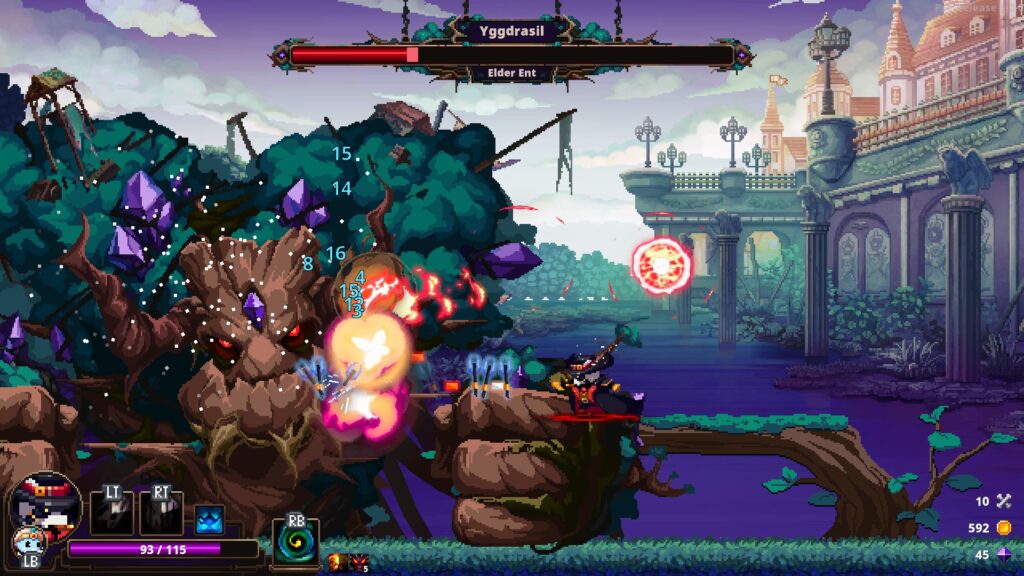
Back in 2013, a little game called Rogue Legacy released and popularized the idea of the “roguelite.” In the case of that game, this new genre mashup consisted of an action-platformer with procedurally generated dungeons, permadeath, and a meta progression system that gave you permanent upgrades to make future runs a bit easier.
Since then, the roguelite has become one of the most widespread and popular genres in the indie game scene. It soon branched out into other genre combinations besides just the action-platformer, like the card-driven combat of Slay the Spire, or the top-down dungeon crawling of Supergiant’s latest indie darling from last year, Hades.
Skul: The Hero Slayer is one of the latest games to take a crack at the roguelite action-platformer genre. I played an early build of the game about a year ago before it hit Early Access, and found it to be a really promising addition to the genre.
It had some unique mechanics and charming pixel art. Now that I’ve had a chance to play the final version, I can safely say that my initial impressions have remained largely unchanged.
Skul: The Hero Slayer
Developer: SouthPAW Games
Publisher: NEOWIZ
Platforms: Windows PC, Linux, Mac
Release Date: January 21st, 2021
Players: 1
Price: $19.99
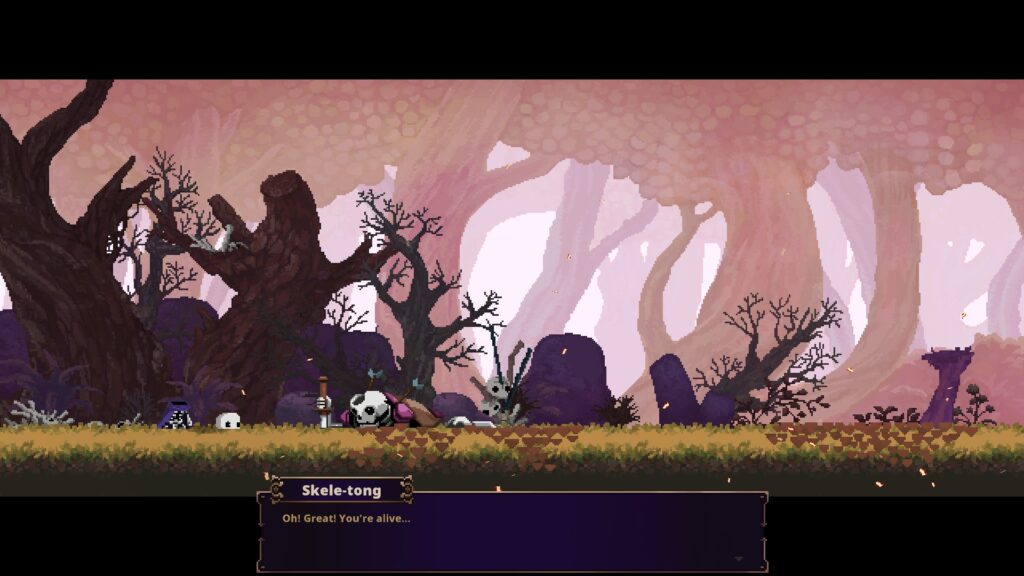
Skul: The Hero Slayer turns the usual fantasy tropes on their head by having you play as the traditional “bad guys.” The Demon King’s castle has been invaded by the Imperial Army, led by a coalition of arrogant “heroes” pursuing the fame and fortune that comes from slaying monsters. The Demon King’s armies were unprepared for this surprise attack, leaving most of his minions broken or captured.
You play as Skul, a small skeleton that must answer the call to action. With many of the Demon King’s champions disposed of, it’s up to you to fight the Imperial Army, rescue any imprisoned subjects, and bring the Demon King back home safely.
The story is mostly secondary to the action, but that isn’t to say that Skul doesn’t have an interesting cast of quirky characters. Most story segments are told in basic text box conversations, with a few key moments leading to basic cutscenes that delve into the backstory of Skul.
This focuses on his relationship with the Demon King and his most trusted adviser, the Witch. These cutscenes feature some voiced narration by the Witch, though it’s all in Korean with English subtitles.
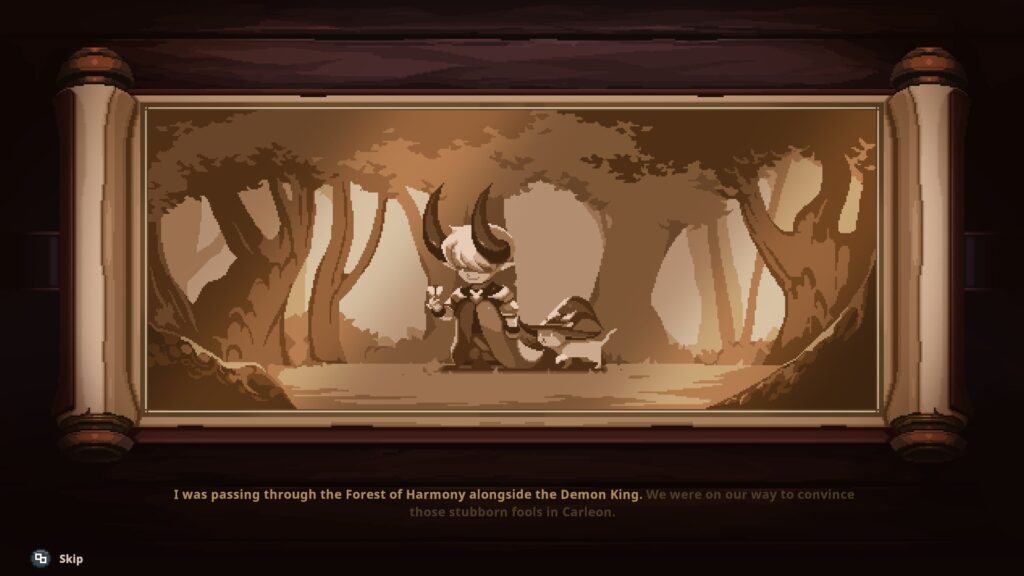
If you’ve played a roguelite in the past five years, then you’ll already be intimately familiar with Skul‘s core gameplay loop. Each run consists of a series of procedurally generated levels full of enemies, traps, and other obstacles. Each level also has a safe zone at set increments where you can buy items, or have a bite to eat to restore some of your health.
Levels are divided into multiple stages, many of which will give you a choice between two doors. As you play, you’ll generally get an idea of what to expect from each stage, based on the design of the door that leads to it. Each level caps off with a massive boss fight before you move on to the next one.
Unlike many roguelites, Skul isn’t fully procedurally generated. Instead, the stages appear to be handcrafted, and then randomly spliced together. This means that you’ll quickly find yourself fighting through the same environments over and over again. On the other hand, this also means that you’ll be able to memorize the various stages, allowing you to prepare for what’s ahead.
As a side effect, this means that you are much less likely to encounter examples of really odd level or encounter designs since they aren’t pieced together by an algorithm. Still, I wish there was greater variety in the stage designs because I started noticed the repeats pretty early on.
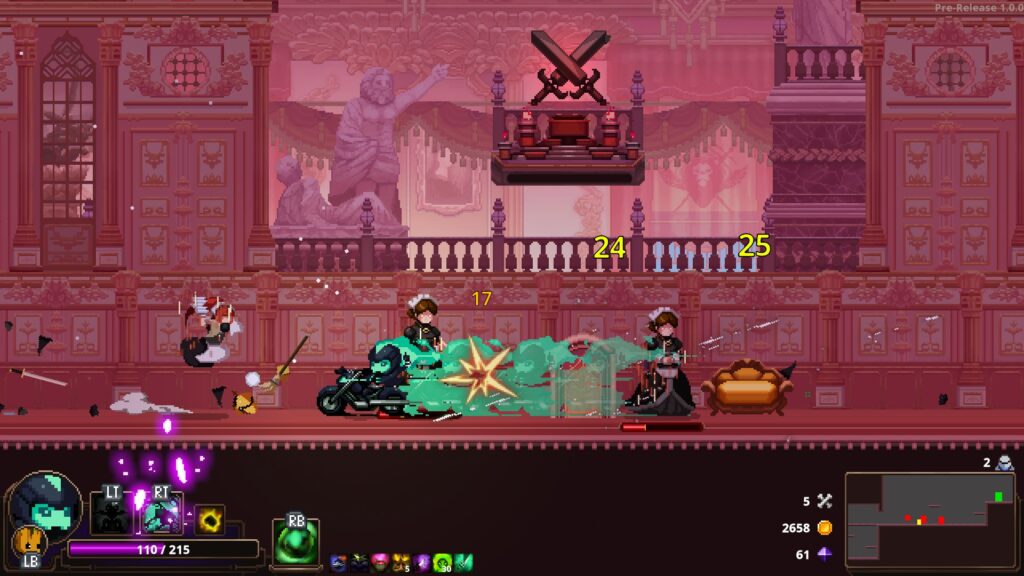
Skul‘s core mechanics revolve around the skull system. Seeing as how Skul is a skeleton, he can swap heads with other skeletons to gain access to their abilities. Each skull has a unique basic attack, one or two special skills, a passive or two, and many also alter your movement in some way. One skull might turn your basic dodge move into a teleport, while another might allow you to glide while in the air.
You can carry two skulls at once, and freely swap between them at will. In fact, swapping is a crucial mechanic to master. Not only does swapping allow you to change your combat strategy on the fly, but each skull has a special skill that activates when you swap.
There is a level of random generation to the skulls as well. While each skull will have the same core passive abilities, the special attacks are drawn from a pool of skills associated with that skull.
For example, the ent skull’s special attack might send out a shockwave of vines in one run, or summon a larger ent that slams the ground and shoots poison bolts in another run. There is even a type of NPC you can rescue that swaps out one skill on your equipped skull for that run.

The game has a massive variety of skulls to discover, and this is definitely its main highlight. You’ll find skulls that run the gambit of fantasy character class and monster tropes. A backstabbing thief that steals gold, a werewolf with fast combos and dash attacks, a genie that can hide in its lamp for temporary invulnerability, and more. There are even some crossover Easter Egg skulls, like The Prisoner from Dead Cells.
One thing you’ll learn very quickly is that not all skulls are created equal. The common skulls tend to be pretty weak, and only come with one special attack and some fairly low tier passive effects and damage output.
The rarer skulls tend to have insane damage output, extremely powerful or unique passive effects, and come with two special attacks. You can collect bone fragments and use them to upgrade skulls from a spider lady at specific points in each level, but even when upgraded the common skulls are something you’ll want to ditch as soon as possible.
Rounding out your arsenal are Quintessence skills and items. A Quintessence is a type of relic that comes with a passive ability, as well as an active skill. You can only have one at a time, and like the skulls, the rarer ones are always significantly better than the common ones.
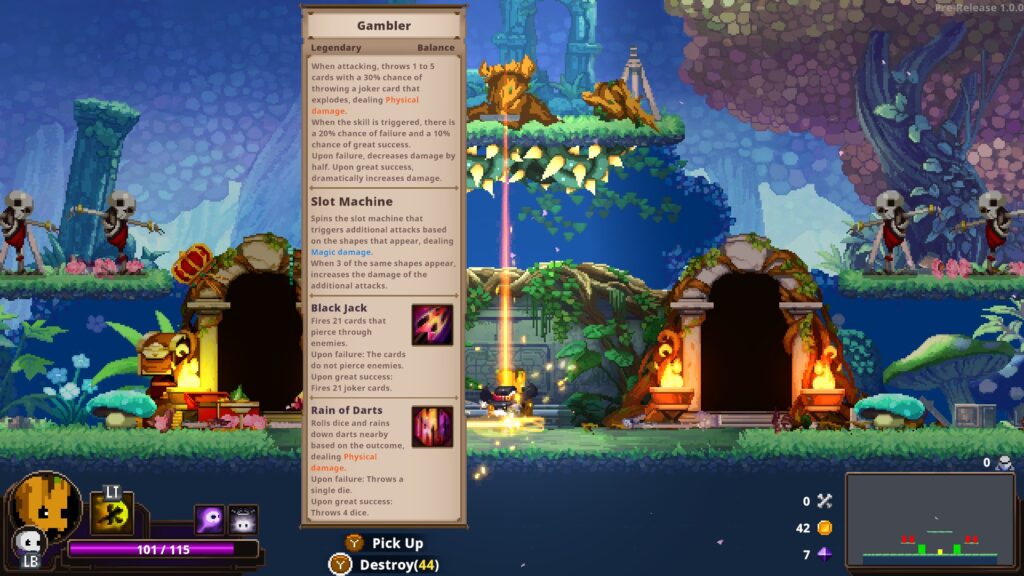
Items are pretty much what it says on the tin. These are pieces of gear that add passive bonuses, like increased damage, increased gold drops, or higher maximum health. You can have nine of them at a time, and like with all things in Skul, the common ones are mostly garbage that you’ll want to cycle out at your first opportunity.
It probably goes without saying, but Skul is a game where your success is generally tied to your RNG. The power disparity between common and rare items is massive, so if you aren’t getting good rares, then your run will probably be over very quickly.
The game’s core mechanics are quite simple, and while your ability to dodge attacks and land blows counts for a lot, if you aren’t getting good skulls or items then you’ll eventually run headlong into a brick wall. This usually comes in the form of a boss with more health than you can safely deal with, dragging out the fight long enough that you eventually make a mistake.
You could argue that the game’s items could use a big rebalance because of this, and I wouldn’t necessarily disagree there. Facing bosses armed primarily with common items and skulls can be a bit of a nightmare, since most of them just aren’t all that good.
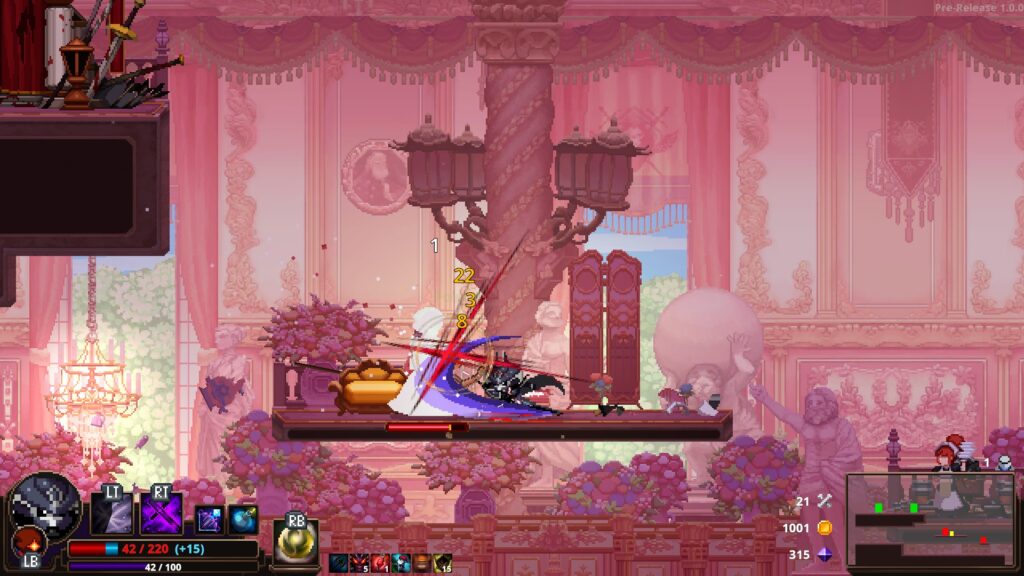
On the other hand, it’s clear that this is kind of the intent. You are definitely supposed to be hunting for those rare and powerful items to ditch the bad commons. That being said, it’s pretty hard to do this when you are so reliant on the game deciding to give you decent gear when you need it most.
While getting bad rolls on the loot chart is always frustrating, Skul still passes the “one more run” test with flying colors. While many of your runs are doomed fairly early on, when you finally do get those powerful skulls and items the game can be loads of fun. Quite a few encounters throw dozens of enemies at you at once, and if you happen to have a skull with flashy moves, it’s immensely satisfying to see enemy soldiers thrown all over the place.
Even a really bad run is probably over so fast that it’s not really a big deal. That said, I do think there is still a lot of room to tweak the game’s difficulty curve. The jump from the first to second level in particular is pretty dramatic, with enemies that have a fairly substantial increase in health and lethality.
Skul‘s presentation is a big part of what makes the game so enduring. It has a pretty solid soundtrack, and as you can probably tell from the screenshots, some really nice pixel art that looks even better in motion.
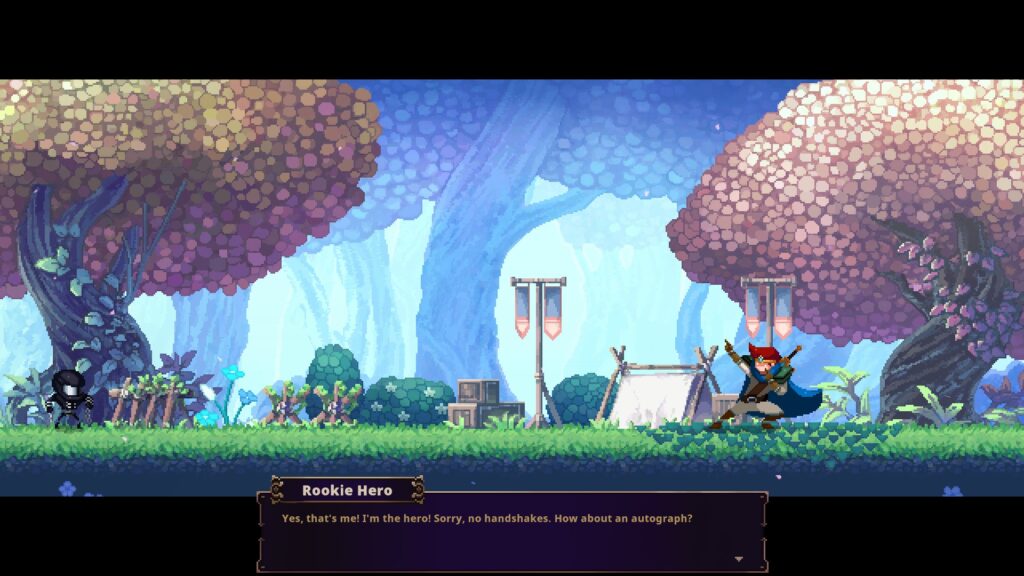
There are lots of cute skull and enemy designs with very smooth animations, and the sheer variety on display is pretty impressive. Every skull looks and feels very unique, and the rarer ones tend to have extremely visually impressive special attacks.
This applies to enemies as well. So many of the character designs just ooze charm; like the maids in the Imperial castle that attack by throwing plates and silverware at you. Or the overconfident rookie adventurer mid-level boss that has attacks based around flexing and practicing heroic poses.
As with all roguelites, Skul does have some meta progression based around rescuing some of the Demon King’s highest ranking servants. The first of these you’ll unlock is the Witch, who you can trade Dark Quartz dropped by enemies for permanent upgrades.
They are all passive effects that you would be familiar with. They increase your max health or physical damage by percentile increments that, while small, gradually add up to a more substantial bonus. Unfortunately, most of these upgrades aren’t all that interesting, and the system overall feels quite grindy.
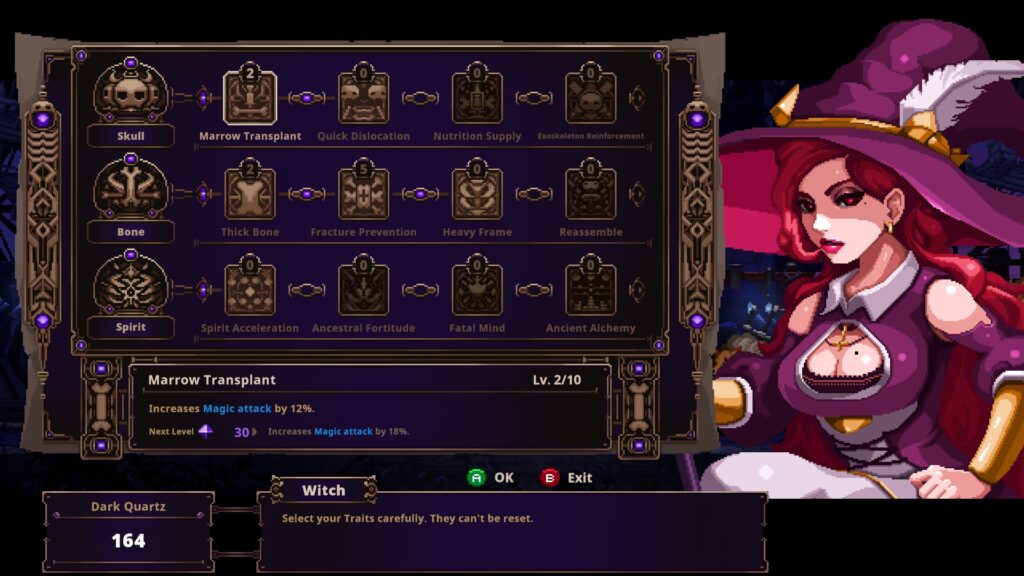
Gaining 4% extra magical damage isn’t all that exciting, especially with how long it can take to save up Dark Quartz. Some of the later upgrades are much more significant, like giving you a single revive per run, but these upgrades cost tons of Quartz, and require you to buy some upgrades before unlocking access to them.
The game certainly isn’t the most complicated or mechanically deep roguelite action-platformer on the market. It doesn’t have the giant build variety and in-depth combat mechanics of something like Dead Cells. That being said, Skul: The Hero Slayer still a great addition to the genre in its own ways.
The skull-based combat system is pretty unique, and there are lots of interesting skulls to discover. It’s never fun to get totally screwed over by the RNG and have a run end really quickly.
However, when you do get those really powerful rare items and skulls, you’ll be treated to an extremely fun power trip full of explosive abilities and flashy combos. The thought of having one of those really good runs again is more than enough to make you want to dive right back in after a crushing failure.
Skul: The Hero Slayer was reviewed on Windows PC using a review code provided by Neowiz Games. You can find additional information about Niche Gamer’s review/ethics policy here.